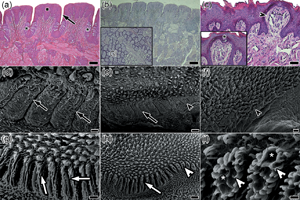Article contents
Structural and Ultrastructural Characteristics of the Spix's Yellow-Toothed Cavy (Galea spixii, Wagler, 1831) Tongue
Published online by Cambridge University Press: 06 June 2022
Abstract

The tongue is a fundamental organ in feeding, vocalization, and grooming. It is characterized by evolutionary adaptations reflected by diet, habitat, and function. Rodents are a very diverse mammalian order and the tongue's morphology varies in size, form, and presence of papillae. This work aimed to describe the morphological and ultrastructural aspects of the tongue of Spix's yellow-toothed cavy (Galea spixii, Wagler, 1831). Tongues of Spix's yellow-toothed cavies were analyzed with light microscopy, scanning, and transmission electron microscopy. The results showed that the tongue was divided into apex, body, and root. There were different types of papillae, such as vallate, foliate, laterally placed fungiform, fungiform, filiform, and robust filiform. The epithelium was organized into layers, including keratinized, granulous, spinous, and basal, below were lamina propria, and musculature, which evolved mucous and serous gland clusters. The tongue of Spix's yellow-toothed cavy was structurally and ultrastructurally similar to other rodents and had papillae with similar morphologies to other Caviidae species. However, the presence of robust filiform papillary lines and laterally placed fungiform papillae showed the main differences from other species. This was the first description of the tongue of Spix's yellow-toothed cavy.
- Type
- Micrographia
- Information
- Copyright
- Copyright © The Author(s), 2022. Published by Cambridge University Press on behalf of the Microscopy Society of America
References
- 1
- Cited by


